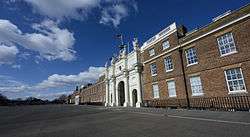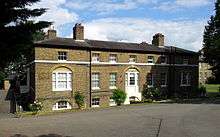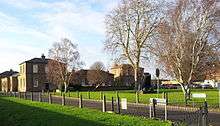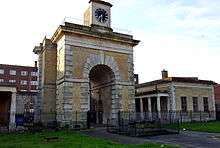Royal Artillery Barracks, Woolwich
The Royal Artillery Barracks at Woolwich in the Royal Borough of Greenwich, London, was the home of the Royal Artillery from 1776 until 2007.
| Royal Artillery Barracks | |
|---|---|
| Woolwich | |
 At 329m the south elevation constitutes the longest continuous architectural composition in London[1] | |
 Royal Artillery Barracks Location within London | |
| Coordinates | 51°29′14″N 0°3′31″E |
| Type | Barracks |
| Site information | |
| Owner | Ministry of Defence |
| Operator | |
| Site history | |
| Built | 1776–1802 |
| Built for | War Office |
| In use | 1802-present |
| Garrison information | |
| Garrison | 1st Battalion, The Royal Anglian Regiment National Reserve Headquarters, Royal Artillery The King's Troop, Royal Horse Artillery Countess of Wessex's String Orchestra |
History
The Barracks were built between 1776 and 1802 on a site overlooking Woolwich Common to accommodate the nascent Royal Artillery, which was fast outgrowing its barracks in the Warren. As originally built (1774-6) the barracks frontage was only half the present length, being the eastern half of the current south elevation, with the pediment and clock positioned centrally. Twenty-five years later, when further expansion was required, it was resolved to double the frontage by building an identical façade to the west, with a wind-dial in place of the clock. The architect James Wyatt then married the two halves together with a centerpiece triumphal arch.
Behind the south frontage the barracks were laid out on a grid pattern, and included soldiers' accommodation, officers' quarters, the officers' mess, a chapel and a library with ancillary buildings further behind along with stores and stables for the horse artillery. Several of these buildings were altered over time or entirely replaced in a number of refurbishment programmes; Wyatt's officers' mess remains in situ.[2] In 1973 the barracks were designated as a Grade II* listed building.[3]
For many years the 17.75-ton Bhurtpore gun, captured by Lord Combermere after the 1826 siege of Bhurtpore, stood outside the barracks.[4][5] To the south, Barrack Field is a cricket ground which has been in use since the mid 18th century.
On 23 November 1981, the Provisional Irish Republican Army targeted Government House of the Royal Artillery on Woolwich New Road in a bomb attack which injured two people.[6] In 1983 the barracks itself was targeted, again by the IRA, in a bombing that injured five soldiers.
21st century

Since the nineteenth century, the appropriateness of Woolwich as a base for the Artillery had been questioned. Suggestions of a move came to nothing until a Defence Estates Review in 2003 proposed a move to Larkhill on Salisbury Plain (where the Royal School of Artillery has been based since 1915). After very nearly 300 years in Woolwich, the last Artillery regiment (the 16th) left the barracks in July 2007.[7] Two stained glass windows from the regimental chapel – one by Christopher Whall, an Arts & Crafts artist – were moved to the Garrison Church of St Alban the Martyr at Larkhill, where they are displayed in lightboxes.[8]
The place of the Artillery was taken by the public duties line infantry battalion and incremental companies of the Foot Guards (who moved in from Chelsea Barracks and Cavalry Barracks). Soon afterwards, the Second Battalion The Princess of Wales’s Royal Regiment was posted to Woolwich from Cyprus. Then in 2012, an artillery link was regained when the King's Troop, Royal Horse Artillery moved from the St John's Wood Barracks to new quarters and stables on the Woolwich site, bringing with them a complement of 120 or thereabouts horses, historic gun carriages and artillery pieces used in their displays.[9]
The shooting events at the 2012 Summer Olympics and Paralympics were held at a temporary venue at the Barracks.[10] The original plan to conduct the shooting at the National Shooting Centre at Bisley, Surrey, was changed after the International Olympic Committee expressed reservations about the number of sports proposed to be staged outside London.
In May 2013 drummer Lee Rigby was murdered by extremists just outside the Barracks in a terrorist attack.[11]
In November 2016 the Ministry of Defence announced that the site would close in 2028.[12]
 The central gateway and parade ground
The central gateway and parade ground The Crimean War Memorial
The Crimean War Memorial Barrack Field with public access path
Barrack Field with public access path Ha-ha between Barrack Field and Woolwich Common
Ha-ha between Barrack Field and Woolwich Common
Related institutions in Woolwich
Woolwich has extensive links with heavy weaponry. Besides the Royal Artillery Barracks it was the location of the Royal Arsenal complex, which was the British Government's principal armaments manufacturing facility for over 200 years (and the original home of the Royal Artillery). The Royal Military Academy which trained artillery officers and engineers from 1741 to 1939 also began in the Arsenal before moving (like the Artillery barracks) onto Woolwich Common in 1806. Rooms in the Arsenal freed by the Academy's move were used to house the Royal Artillery Museum, which itself moved to the Common in 1820, where it was housed in the newly-rebuilt Rotunda. (In 2001 the museum returned to the Arsenal site and was renamed Firepower; but in 2016 it closed, pending relocation to Larkhill.)

In 1780, shortly after the opening of the Barracks, the Royal Artillery Hospital was opened on a nearby site to the east - one of the first purpose-built military hospitals in England; it was later expanded, first in 1801 and then in 1816. In 1865, the ground-breaking Royal Herbert Hospital was opened at the southern end of the Common; the earlier hospital was then converted to serve as barracks for the Military Train (forerunners of the Royal Army Service Corps); the RASC remained associated with these barracks, later known as Connaught Barracks, until 1962, when the Corps was amalgamated and the site redeveloped).[13] The eighteenth-century buildings survive as Connaught Mews, an apartment complex off Grand Depot Road.
In 1781 a Royal Artillery regimental garden was laid out to the east of the Barracks, north of the hospital. A small garden survived there for the next 180 years, but from 1804 most of the area was given over to artillery storage: four long low sheds were built on the site, flanking a central range of workshops and offices, with a pair of magazines alongside to the west. Known as the Grand Depot, it was built as headquarters for the Ordnance Field Train (a precursor to the Royal Army Ordnance Corps) which was disbanded in 1855. In 1856, a Royal Army Clothing Department factory was built on the site of the two magazines (and much of the remaining garden); twelve years later, the factory moved to Pimlico, whereupon its building became the main block of what came to be known as Grand Depot Barracks (which covered the old Grand Depot site and served as an extension of the adjacent RA Barracks). In the 1870s some of the old sheds were converted for use as stables for the officers' horses and a pair of buildings were erected nearby to serve as a riding school and a 'manège' (a swordsmanship arena) for Artillery officers.[14] The surviving Grand Depot buildings (including the listed central block of 1805) were demolished in 1970.
In 1803 a barracks was built further to the east (south of Love Lane, west of Thomas Street), to designs by Wyatt, to serve as headquarters for the Royal Military Artificers (later renamed the Royal Sappers and Miners) who, like the Royal Artillery, were under the Board of Ordnance rather than the War Office. In 1856 the Sappers and Miners were amalgamated into the Royal Engineers and a new Corps headquarters was established in Chatham. Thereafter, their Woolwich barracks initially served as overflow accommodation for cadets of the Royal Military Academy, but were soon given over to the Royal Artillery and annexed to what was now the Grand Depot Barracks next door. A small detachment of Royal Engineers remained, however, to serve the needs of the Arsenal and the Garrison, and the barracks continued in the 20th century to be known as the Royal Engineer Barracks (they were also known as Lower Barracks). They too were listed and yet were demolished in 1970.[2]

Woolwich Common itself has long been used for military purposes. In 1802-4 four Acts of Parliament transferred ownership of the Common (which until then had been grazing land) to the military; (a 'gatehouse' on Repository Road, built to accommodate soldiers guarding the garrison, dates from this time).[15] Thereafter it served as a proving ground for artillery: guns were regularly tested there until the establishment of the Artillery Gunnery School at Shoeburyness in 1859. It is still a designated military training area although troops are not so often seen nowadays. The western edge of the Common was the location of the Shrapnel Barracks, also used by the Royal Artillery.
From 1802, the open ground to the west of the Common became a field training ground known as the Repository Grounds. The ground was laid out with trees, ditches, ponds, ravines, earthworks, and other structures in order to train troops in the movement of guns, ammunition and heavy equipment across difficult terrain; workshops and carriage stores were built at the same time to service the site. This specialist training facility had been instituted by Sir William Congreve in the 1770s; he first established it alongside the Royal Military Repository within the Arsenal, which gave the training ground its name. As of 2012 the Repository Grounds were still used for training as well as providing new accommodation and stables for the King's Troop, Royal Horse Artillery.[2]

A regimental school was opened nearby in 1808; the Royal Artillery School buildings (dating from the 1850s) can still be seen in Greenhill Terrace. The Royal Artillery Institution, which began as a scientific club for officers, first met in an observatory that stood nearby in 1838; in 1854 it moved into new purpose-built accommodation just to the east of the Royal Artillery Barracks.[14] In 1941 the RA Institution was destroyed by enemy action; after the war it occupied the main block of the former Royal Military Academy (which had itself moved to Sandhurst); the rest of the Academy buildings became an extension of the Garrison.

St George's Garrison Church was built on the eastern edge of the Common in 1863 (replacing a chapel within the barracks, which was converted to serve as a theatre). Romanesque in style with Byzantine detailing, it was largely destroyed by a V1 flying bomb on 14 July 1944, but the ruins have been preserved as a memorial.

Woolwich Dockyard was one of the principal Royal Dockyards during the Tudor and Stuart periods; it closed in 1869 as the Thames was by then too difficult to navigate for the naval vessels of the time, and most of the site then served as an overflow depot for the Arsenal's ordnance stores.[16] The Royal Marines, who had provided a military presence in the Dockyard, were housed in their own barracks just to the south, in Frances Street. After closure of the dockyard (and the consequent departure of the Marines) these barracks were renamed Cambridge Infantry Barracks and they went on to house various regiments until (despite being listed) they were almost entirely demolished in 1972.[17] The adjacent Royal Marine Infirmary was likewise renamed in 1869 as Red Barracks, Woolwich; it went on to serve as headquarters of the Royal Army Ordnance Corps until 1921. From 1885, the barracks also housed Artillery College (formed out of the Royal Artillery Institution) until its move to Shrivenham at the start of the Second World War; afterwards, the Royal Artillery Records Office was based there. Again, despite being listed in 1972, Red Barracks was demolished in 1975; the perimeter wall remains.[18]
On the northwest corner of Frances Street and Hillreach, opposite the barracks security gate, is the Kings Arms pub, targeted by the IRA in November 1974 in a bombing which killed Royal Artillery Gunner Richard Dunne and another man, and injured 35 others.[19]
See also
- Royal School of Artillery
- Wentworth Woodhouse, another building with a long facade
References
- Jones & Woodward, The Architecture of London, 1983 ff
- The Survey of London: Woolwich (2012)
- Historic England. "Royal Artillery Barracks Main Building (1078918)". National Heritage List for England. Retrieved 29 July 2016.
- "Obituary: Viscount Combermere". The Daily Telegraph. 16 November 2000. Retrieved 1 December 2015.
- Murray, John (1878). Handbook for England and Wales: Alphabetically Arranged for the Use of Travellers ... J. Murray. p. 486.
- https://api.parliament.uk/historic-hansard/written-answers/1996/mar/04/terrorist-incidents
- "End of an era for historic barracks". News Shopper. 6 August 2007. Archived from the original on 28 September 2007. Retrieved 29 July 2016.
- "Woolwich to Larkhill". Sunrise Stained Glass Ltd. Retrieved 29 July 2016.
- King's Troop moves to its 'spiritual home' in Woolwich at BBC News, 7 February 2012. Accessed 8 February 2012
- London2012.com profile of the venue. Archived 5 September 2012 at Archive.today - accessed 10 May 2012.
- Woolwich attack: murdered soldier Drummer Lee Rigby 'would do anything for anybody’ - Telegraph
- "A Better Defence Estate" (PDF). Ministry of Defence. November 2016. Retrieved 8 November 2016.
- "Connaught Mews History".
- Vincent, William Thomas (1885). Woolwich: Guide to the Royal Arsenal &c. London: Simpkin, Marshall & co. p. 55. Retrieved 6 August 2018.
- "Woolwich Common Conservation Area Appraisal". Royal Borough of Greenwich. Retrieved 10 August 2016.
- "The Royal Dockyards of Deptford and Woolwich". Retrieved 21 August 2012.
- Bedford, Kristina (2014). Woolwich Through Time. Amberley Publishing. ISBN 978-1-445615998.
- The Survey of London: Woolwich (2012)
- "History repeating itself: Same barracks were targeted by IRA bombers nearly 40 years ago". Express. 23 May 2013. Retrieved 18 April 2018.
External links
- Location map - aerial photo also available
- History of the Royal Artillery Theatre
Census Returns
- 1891 UK Census class:RG12. piece:534. folio=66. p. 1. - Woolwich Arsenal Grand Depot Barracks & Cambridge Cottages
| Wikimedia Commons has media related to Royal Artillery Barracks. |


